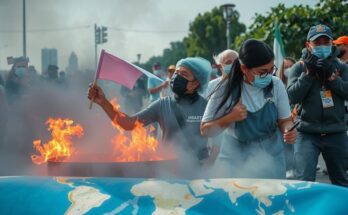Southern Africa is facing the worst drought in a century, with over 27 million people impacted and 21 million children malnourished. Countries such as Lesotho, Malawi, Namibia, Zambia, and Zimbabwe have declared national disasters as crop failures and livestock losses mount. The crisis is expected to deepen until the next harvests in March and April. The drought, exacerbated by the El Niño phenomenon and climate change, poses severe humanitarian risks in a region reliant on rain-fed agriculture.
Southern Africa is experiencing the most severe drought in a century, leaving over 27 million individuals affected, according to the United Nations World Food Programme (WFP). The persistent drought has led to widespread hunger and malnutrition, particularly affecting children, of whom 21 million are reported to be malnourished. Several nations, including Lesotho, Malawi, Namibia, Zambia, and Zimbabwe, have declared national disasters as the drought has decimated crops and livestock. Angola and Mozambique are similarly experiencing dire conditions. The WFP has indicated that the crisis is anticipated to worsen until the next harvests, expected in March or April of the following year. Tomson Phiri, a spokesperson for the WFP, emphasized the gravity of the situation, stating, “A historic drought – the worst food crisis yet – has devastated more than 27 million lives across the region.” As October marks the onset of the lean season in Southern Africa, forecasts predict that conditions will deteriorate with each passing month until the harvest next year. Those reliant on small-scale agriculture, predominantly dependent on rainfall, are facing acute food shortages due to crop failures and livestock deaths. The El Niño weather phenomenon has contributed to this crisis by causing significantly below-average rainfall, compounded by rising temperatures attributed to climate change. The drought has resulted in substantial losses, with reports indicating that 70 percent of the harvest in Zambia and 80 percent in Zimbabwe have been obliterated, according to Lola Castro, the WFP’s acting regional director for southern Africa. Furthermore, the drought has severely curtailed hydropower capacity in the region, leading to substantial electricity shortages. In response to dwindling resources, authorities in Zimbabwe and Namibia have resorted to culling wildlife, including elephants, to alleviate hunger among the population. Sub-Saharan Africa is exceptionally vulnerable to climate change due to its heavy reliance on rain-fed agricultural systems and natural resources, with millions of livelihoods under threat. Additionally, experts have raised concerns that climate-induced changes in weather patterns are adversely affecting crop yields, development, flavor, and harvesting times.
The drought currently afflicting Southern Africa represents a poignant intersection of climatic phenomena and socio-economic realities. The El Niño weather pattern has drastically reduced rainfall in an already vulnerable region that is dependent on agriculture, primarily rain-fed. Climate change has exacerbated these conditions, making communities increasingly incapable of adapting or mitigating the effects of such climate-induced disasters. The socioeconomic ramifications are dire, particularly for those whose livelihoods revolve around small-scale farming, leading to widespread food insecurity and malnutrition.
In conclusion, the unprecedented drought sweeping across Southern Africa has resulted in a humanitarian crisis, affecting over 27 million individuals and leaving many children malnourished. The situation is poised to worsen, as the effects of climate change coupled with the enduring impacts of the El Niño phenomenon continue to destabilize agricultural production. Immediate international attention and aid are essential to mitigate the impending catastrophe and support the affected populations in this vulnerable region.
Original Source: www.aljazeera.com




